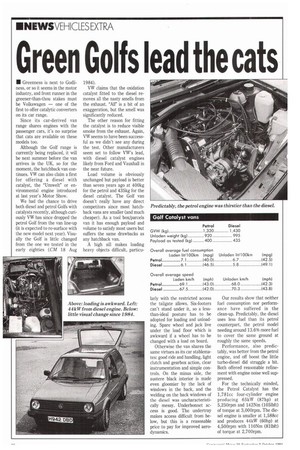Green Golfs lead the cats
Page 24

If you've noticed an error in this article please click here to report it so we can fix it.
• Greenness is next to Godliness, or so it seems in the motor industry, and front runner in the greener-than-thou stakes must be Volkswagen — one of the first to offer catalytic converters on its car range.
Since its car-derived van range shares engines with the passenger cars, it's no surprise that cats are available on these models too.
Although the Golf range is currently being replaced, it will be next summer before the van arrives in the UK, so for the moment, the hatchback van continues. VW can also claim a first for offering a diesel with catalyst, the "Umwelt" or environmental engine introduced at last year's Motor Show.
We had the chance to drive both diesel and petrol Golfs with catalysts recently, although curiously VW has since dropped the petrol Golf from the van line-up (it is expected to re-surface with the new model next year). Visually the Golf is little changed from the one we tested in the early eighties (CM 18 Aug
1984).
VW claims that the oxidation catalyst fitted to the diesel removes all the nasty smells from the exhaust. "All" is a bit of an exaggeration, but the smell was significantly reduced.
The other reason for fitting the catalyst is to reduce visible smoke from the exhaust. Again, VW seems to have been successful as we didn't see any during the test. Other manufacturers seem set to follow VW's lead, with diesel catalyst engines likely from Ford and Vauxhall in the near future.
Load volume is obviously unchanged but payload is better than seven years ago at 400kg for the petrol and 435kg for the diesel catalyst. The Golf van doesn't really have any direct competitors since most hatchback vans are smaller (and much cheaper). As a tool box/parcels van it has enough payload and volume to satisfy most users but suffers the same drawbacks as any hatchback van.
A high sill makes loading heavy objects difficult, particu
larly with the restricted access the tailgate allows. Six-footers can't stand under it, so a lessthan-ideal posture has to be adopted for loading and unloading. Spare wheel and jack live under the load floor which is awkward if a wheel has to be changed with a load on board.
Otherwise the van shares the same virtues as its car stablemates: good ride and handling, light clutch and gearbox action, clear instrumentation and simple controls. On the minus side, the austere black interior is made even gloomier by the lack of windows in the back, and the welding on the back windows of the diesel was uncharacteristically messy. Underbonnet access is good. The undertray makes access difficult from below, but this is a reasonable price to pay for improved aerodynamics. Our results show that neither fuel consumption nor performance have suffered in the clean-up. Predictably, the diesel uses less fuel than its petrol counterpart, the petrol model needing around 13.6% more fuel to cover the same ground at roughly the same speeds.
Performance, also predictably, was better from the petrol engine, and off boost the little turbo-diesel did struggle a bit. Both offered reasonable refinement with engine noise well suppressed.
For the technically minded, the Petrol Catalyst has the 1,781cc four-cylinder engine producing 65kW (87hp) at 5,250rpm and 142Nm (105Ibft) of torque at 3,000rpm. The diesel engine is smaller at 1,588cc and produces 44kW (60hp) at 4,500rpm with 110Nm (81Ibft) of torque at 2,700rpm.




































































































